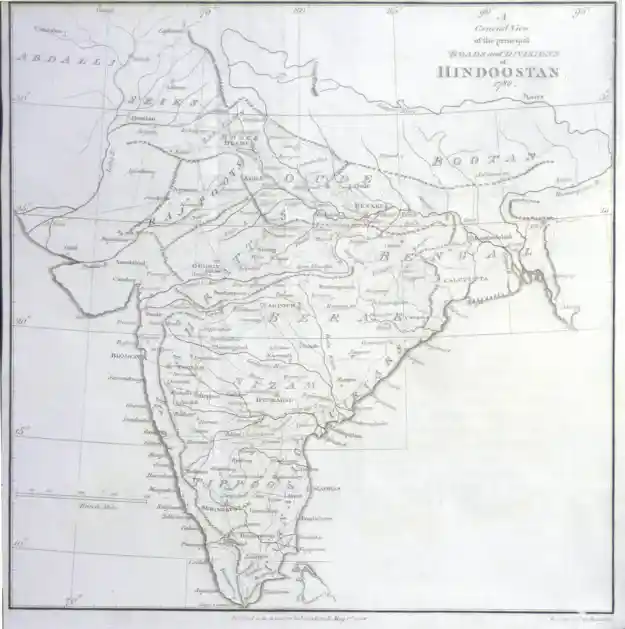A product of colonialism?
It is believed that nearly every aspect of modern India is a product of British colonialism. Unfortunately, it is true. The British built roads, railways, industries, and many buildings that continue to remind us that we continue to live in an India, that is undoubtedly western in its designs. Indeed, the very map of India, the one we have drawn countless times in our geography classes, is a British product. How is that possible, you might wonder? Let’s find out.

James Rennell’s Map of Hindoostan. Source: Arisebharat
While analysing the causes and nature of British colonialism in India, we often limit our focus to the obvious narratives, attributing political, military, and economic supremacy to the success of the imperialist policies of the British. We tend to overlook the importance of ideas and practices developed by the British in India and how they played a crucial role in creating spaces and territories, suited exclusively for colonial governance, exploitation, and violence.
The ideas of mapping and creating an India, based purely on the geographical conceptions of the British had an everlasting impact on how landscapes and boundaries came to be perceived by the people of India in the modern period. The fact that maps are inherently a product of imperialism and colonialism seldom strikes our minds.
The practice of cartography or map-making initiated by the British in the 18th century was highly inspired by the western ideals of Enlightenment.
It was James Rennell, a British geographer, who first created a map, encompassing nearly every territory that now falls within India. His map was titled the “Memoir of a Map of Hindoostan”. Because of his contributions, Rennell is revered as the father of Indian Geography.
But what we fail to realize is that Rennell did not simply chart out existing territories of the country and projected them on the maps. The India that Rennell created was based solely on how the British wanted him to visualize and draw India. So what Rennell created as a tool for the British to further their territorial conquests and establish their political claims over India.
The map created by Rennell, in a way, was a prized possession of the British, one that symbolized their legitimate authority over India. The intention was simple. The British were scientifically superior to the Indians. They could make maps, but the Indians could not. Back at home, the British proudly displayed these maps as symbols of territorial and geographical conquests and the success of British imperialism. They were hung up on the walls of Council Chambers or in British classrooms, allowing the imperial citizens to take pride in the achievements of their nation.
Ironically, the very people whose lands were being mapped remained isolated from this grand project. The maps were not for the Indian people rather they were designed exclusively for the British officials and British audience.
Apart from Rennell, many other surveyors, and cartographers take the credit (or blame) for manipulating the territories of India to suit imperial needs. We are all familiar with George Everest, the brave and young official who undertook the difficult journey and successfully ‘discovered’ Mount Everest. In the efforts of glorifying his achievements, we lost the chance of familiarizing ourselves with the indigenous name of the highest mountain of the world.
Some might say that the British have done more good than harm to India. They heralded modernity and left many legacies. However, to what extent is this true? The fact that we continue to identify Indian places with the names of some strange British men, should make us pause and wonder:
Are we truly independent? Or do we continue to live under the shadows of colonialism and imperialism?


